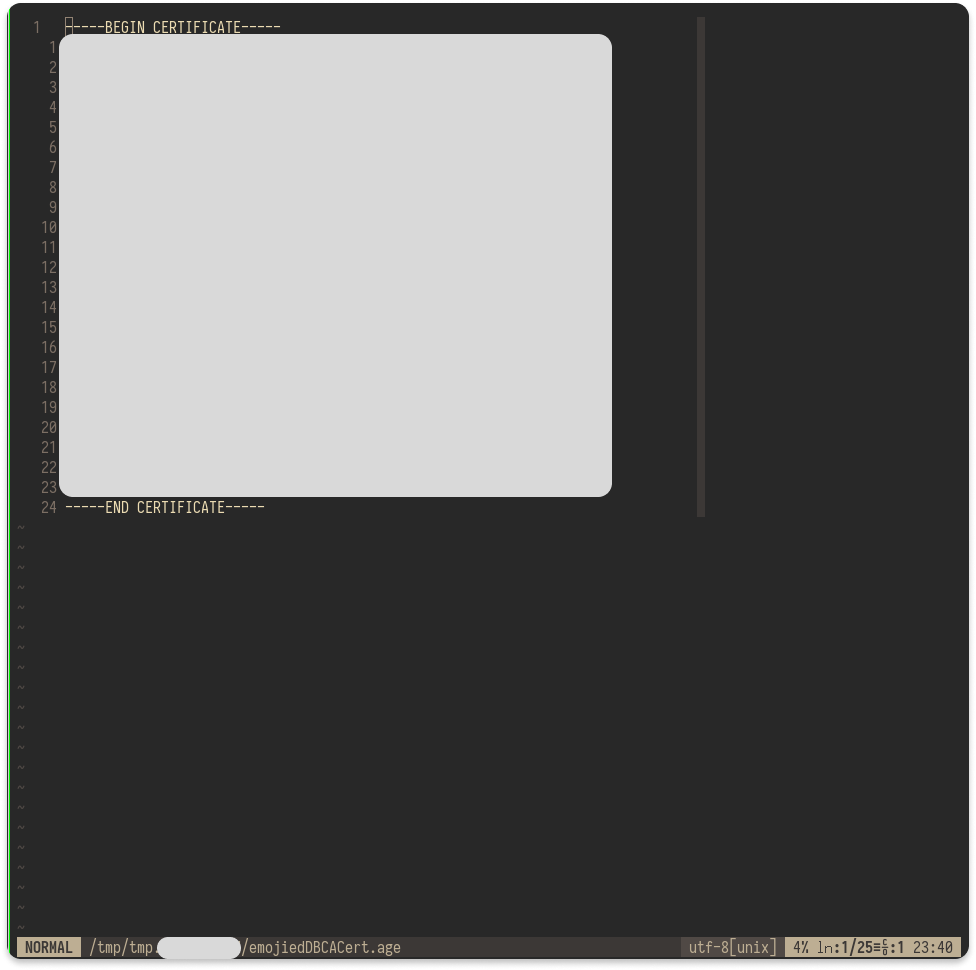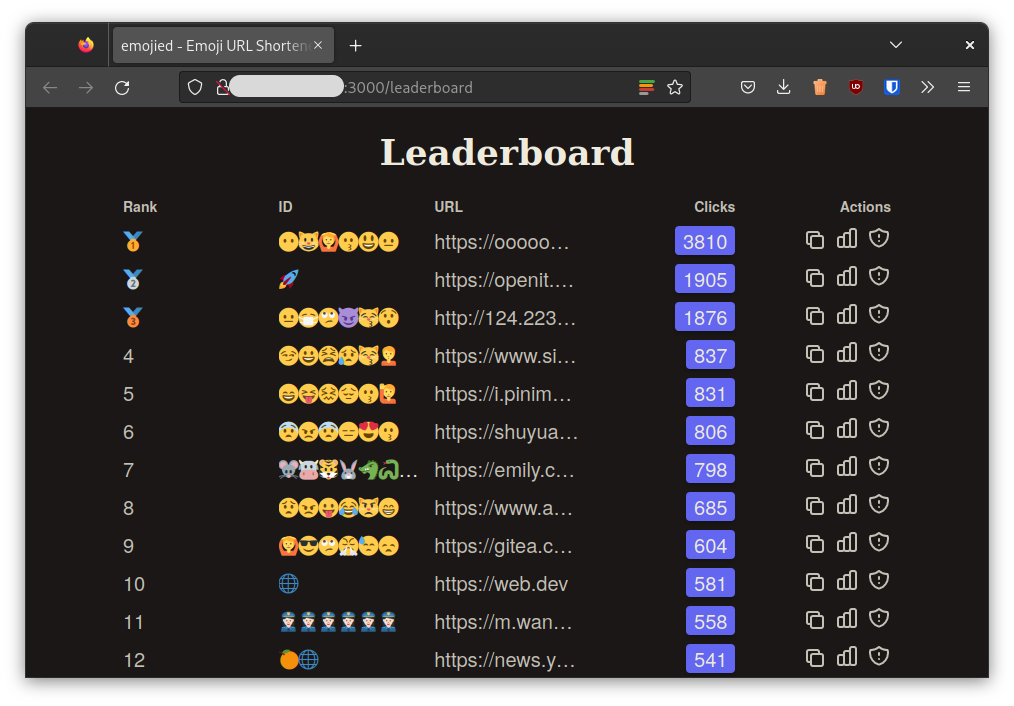

Recently, I experimented with running NixOS on a DigitalOcean droplet (which I will probably write about in the future), and migrated some of my toy projects from App Platform. During the migration process, I realized that I would have to somehow handle the DB certificate, and other sensitive credentials. I can’t just hardcode these!
One of the more popular projects for problems like this is agenix. Their README for how to use it was a bit confusing (for me) so hopefully this post will be of use to others.
There are two parts to this post: 1) creating secrets with agenix, and 2)
reading said secrets in a remote NixOS server. Of course you could use it for
different things, and my example isn’t exactly the simplest.
ℹ️ I’m not saying this is the best way to do things. Please let me know if there are any glaring issues you find!
Here’s a checklist for what’s needed:
agenix CLI present in your computeragenix’s module to the system you want secrets to be read inInstalling agenix is documented well in their README so feel free to consult
it.
agenixSecrets are encrypted and stored by agenix in these things called age files.
These files have the .age format which is created by the agenix CLI. For
you to create an age file, the CLI looks for a secrets.nix file in the current
directory for the rules to determine who is allowed to decrypt it.
So, what are these rules?
Let’s see what the agenix CLI says:
$ agenix
agenix - edit and rekey age secret files
agenix -e FILE [-i PRIVATE_KEY]
agenix -r [-i PRIVATE_KEY]
options:
-h, --help show help
-e, --edit FILE edits FILE using $EDITOR
-r, --rekey re-encrypts all secrets with specified recipients
-i, --identity identity to use when decrypting
-v, --verbose verbose output
FILE an age-encrypted file
PRIVATE_KEY a path to a private SSH key used to decrypt file
EDITOR environment variable of editor to use when editing FILE
RULES environment variable with path to Nix file specifying recipient public keys.
Defaults to './secrets.nix'
agenix version: 0.13.0
age binary path: /nix/store/kfasn0129ac0xn8wfvf7mq38rxhbc725-rage-0.8.1/bin/rage
age version: rage 0.8.1
Specifically:
RULES environment variable with path to Nix file specifying recipient public keys. Defaults to ‘./secrets.nix’
In the aforementioned file, we’re able to say whose key can decrypt what age file. Let’s create this file first.
# We'll store the rules, and age files in the `secrets` folder
mkdir secrets
touch secrets.nix
For the example later, I’ll need two files: one containing the DB CA certificate, and the DB password. So I’ll create a rule for each age file I’m going to generate later on.
Here’s how it looks like:
# secrets/secrets.nix
let
peepeepoopoo = "ssh-ed25519 AAAAC3NzaC1lZDI1NTE5AAAAIB/Oxx/jZS7TRqjp2kwaYavzcxxKFTrStikFrtZq3q3l root@peepeepoopoo";
in {
"emojiedDBPassword.age".publicKeys = [ peepeepoopoo ];
"emojiedDBCACert.age".publicKeys = [ peepeepoopoo ];
}
When decrypting/creating emojiedDBPassword.age for example, agenix looks for
the private key pair of the public key that was supplied. Otherwise, it prohibits
the user from doing so, and will complain about there not being any matching keys.
ℹ️ You don’t need the rules file for decrypting an age file because the permissions are already encoded in the age file. You should only have it present if you’re using the CLI for creating/updating an age file.
We’ll need the agenix CLI to create an age file containing our encrypted secret,
and run this:
$ agenix -e emojiedDBCACert.age
This opens a text editor for you to put the secret in.

If you need to add public keys for existing age files, update the secrets.nix
file accordingly, and run agenix -r. Make sure you’re in the same directory
as the secrets.nix, and age files.
It would show you something like this if it succeeds:
$ agenix -r
rekeying emojiedDBCACert.age...
rekeying emojiedDBPassword.age...
Now our age files are ready to be used!
I mentioned earlier that my use case is for supplying the DB CA certificate, and
DB password to the emojied app for it to connect with
the DB properly. I won’t get into the details of how I set up the server. Rather,
I’ll just include the parts necessary. If you wish to read the full config files,
check the repo although peepeepoopoo here
is a throwaway server. Hence not in the repo.
What I need in the remote server called peepeepoopoo (where emojied is
running) are the ff:
agenix NixOS moduleflake.nix:
{
description = "Example";
inputs = {
nixpkgs.url = "github:NixOS/nixpkgs/nixos-22.05";
emojiedpkg.url = "github:sekunho/emojied";
agenix.url = "github:ryantm/agenix";
};
outputs = {
self,
nixpkgs,
emojiedpkg,
agenix
}:
let
system = "x86_64-linux";
pkgs = nixpkgs.legacyPackages.${system};
emojied = emojiedpkg.packages.${system}.emojied;
in {
nixosConfigurations.peepeepoopoo = nixpkgs.lib.nixosSystem {
inherit system;
modules = [
emojiedpkg.nixosModule
./hosts/peepeepoopoo/configuration.nix
agenix.nixosModules.age
];
# Applies the configuration.nix function to these arguments
specialArgs = {
inherit pkgs;
inherit emojied;
};
};
};
}
All that’s left to do is specify where the age files are located, and referencing the decrypted age files’ paths.
hosts/peepeepoopoo/configuration.nix:
{ modulesPath, lib, config, pkgs, ... }: {
imports = lib.optional (builtins.pathExists ./do-userdata.nix) ./do-userdata.nix ++ [
(modulesPath + "/virtualisation/digital-ocean-config.nix")
];
programs.ssh = {
startAgent = true;
extraConfig = ''
AddKeysToAgent yes
'';
};
nix = {
package = pkgs.nixVersions.nix_2_9;
extraOptions = ''
experimental-features = nix-command flakes
'';
settings.trusted-public-keys = [
"hydra.iohk.io:f/Ea+s+dFdN+3Y/G+FDgSq+a5NEWhJGzdjvKNGv0/EQ="
"iohk.cachix.org-1:DpRUyj7h7V830dp/i6Nti+NEO2/nhblbov/8MW7Rqoo="
"nix-community.cachix.org-1:mB9FSh9qf2dCimDSUo8Zy7bkq5CX+/rkCWyvRCYg3Fs="
];
settings.substituters = [
"https://cache.iog.io"
"https://iohk.cachix.org"
"https://nix-community.cachix.org"
];
};
age = {
# We're letting `agenix` know where the locations of the age files will be
# in the server.
secrets = {
emojiedDBPassword.file = "/root/secrets/emojiedDBPassword.age";
emojiedDBCACert.file = "/root/secrets/emojiedDBCACert.age";
};
# Private key of the SSH key pair. This is the other pair of what was supplied
# in `secrets.nix`.
#
# This tells `agenix` where to look for the private key.
identityPaths = [ "/root/.ssh/id_ed25519" ];
};
# List services that you want to enable:
services = {
emojied = {
enable = true;
port = "3000";
dbHost = "<REPLACE_WITH_YOUR_OWN>";
dbName = "<REPLACE_WITH_YOUR_OWN>";
dbPort = "<REPLACE_WITH_YOUR_OWN>";
dbUser = "<REPLACE_WITH_YOUR_OWN>";
dbPoolSize = "5";
dbPasswordFile = config.age.secrets.emojiedDBPassword.path;
dbCACertFile = config.age.secrets.emojiedDBCACert.path;
};
openssh = {
enable = true;
permitRootLogin = "prohibit-password";
passwordAuthentication = false;
};
};
networking = {
firewall = {
enable = true;
allowedTCPPorts = [ 22 3000 ];
};
};
# List packages installed in system profile. To search, run:
# $ nix search wget
environment = {
systemPackages = with pkgs; [];
loginShellInit = ''
export SSH_AUTH_SOCK="$XDG_RUNTIME_DIR/ssh-agent.socket"
'';
};
system.stateVersion = "22.05";
}
Now we can move the secrets folder, and the SSH key (if it’s not already there)
from our host machine to the remote server.
$ scp secrets root@<SERVER_IP>:/root/
$ scp ~/.ssh/<YOUR_KEY> root@<SERVER_IP>:/root/.ssh/id_ed25519
$ scp ~/.ssh/<YOUR_KEY>.pub root@<SERVER_IP>:/root/.ssh/id_ed25519.pub
Then hit build and apply the config:
$ nixos-rebuild switch \
--flake .#peepeepoopoo \
--target-host root@<SERVER_IP> \
--build-host localhost
copying 3 paths...
copying path '/nix/store/lali119kww58c4df3b1w61yzg5an1mr7-system-units' to 'ssh://root@<SERVER_IP>'...
copying path '/nix/store/g1izspgbn34hmlll2hby5qapx90nm43p-etc' to 'ssh://root@<SERVER_IP>'...
copying path '/nix/store/739zphavd4d1vjfnd8v2b1bpm0dzwxz6-nixos-system-unnamed-22.05.20221024.6107f97' to 'ssh://root@<SERVER_IP>'...
updating GRUB 2 menu...
stopping the following units: emojied.service
activating the configuration...
[agenix] creating new generation in /run/agenix.d/1
[agenix] decrypting secrets...
decrypting '/root/secrets/emojiedDBCACert.age' to '/run/agenix.d/1/emojiedDBCACert'...
decrypting '/root/secrets/emojiedDBPassword.age' to '/run/agenix.d/1/emojiedDBPassword'...
[agenix] symlinking new secrets to /run/agenix (generation 1)...
[agenix] chowning...
setting up /etc...
reloading user units for root...
setting up tmpfiles
starting the following units: emojied.service
the following new units were started: run-agenix.d.mount
Which gives me this beautiful creation:
